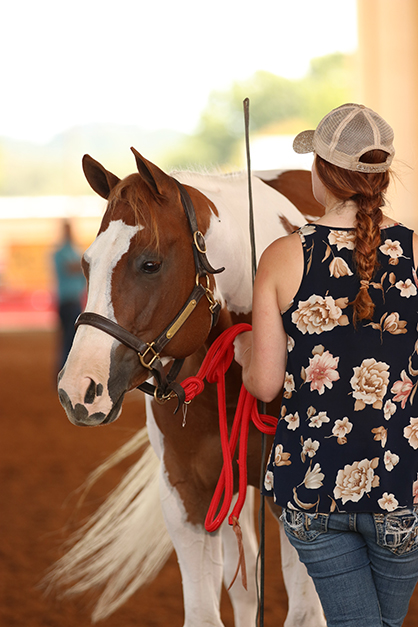Yikes! My Horse Has No Tail!
By: Nikki Alvin-Smith for Horsemen’s Laboratory
Most of us have experienced that moment when our horse turns around in his stall and we see that his beautifully groomed and carefully hand combed tail, that we have been nurturing all show season, has become a tangled mess. The skirt hairs are missing, or scrunched into a new backcomb style.
Water buckets are squished out of shape, bits of horse tail hair caught on their handles, and your horse just looks at you like, “What?”
A horse can itch for many reasons, but a common cause is the dastardly pinworm. This issue is most prevalent in young horses. On close examination of the horse’s rectum, you may even see a worm dangling halfway out. Disgusting, I know! This is the female pinworm laying her eggs around the exterior of the rectal ring with a glue like material. The female pinworm will die after laying her eggs and the glue will dry and cause intense itching. The horse will consequently itch its tail head on any available surface. Whitish, light green, yellowish or gray patches of eggs may be seen and these patches can contain as many as several x 100,000 microscopic eggs in this egg-white consistency film.
As these worms will not be seen in a FECT (fecal egg count test) the best way to ascertain whether your horse is harboring pinworms is with a special test that is akin to placing a piece of sticky tape across the horse’s rectum, aptly called the ‘Scotch Tape Technique” then removing it and looking at the results under a microscope. Alternatively, a lubricated wooden tongue depressor can be used to scrape the skin surrounding the anus to collect a sample of the material and place on it on a slide, or popsicle sticks can be utilized to collect the material and sent to the laboratory for testing. It is important that when collecting this sample the person responsible does not take for granted their risk for injury from a kick or adverse reaction to the procedure from the horse. A firm but gentle scraping of the rectal ring is required and although a horse may be generally quiet and easy to work around be aware the procedure may provoke a defensive response.
The presence of pinworms in a sample can be hard to detect so it does require a professional eye. If you purchase an FECT sample kit online, the lab may include this extra test for free so just ask for it at the time you place your order.
While pinworm infection was most commonly seen in young horses, recent studies suggest there is an upward trend in the pinworm population being hosted in adult horses. There are also indications that the pinworm may be resistant to treatment with Ivermectin. The recommended treatment at this time is a benzimidazole dewormer.
If your horse is in significant discomfort and you have ascertained this itching is caused by pinworms, you can bathe the perianal region to help relieve the itching. Sometimes, although the glue like material has dried and been cleaned, the horse may still have soreness and dry or cracked tissue around at the tail head that causes the horse to continue to rub its tail. Application of a cortisone cream or other steroidal salve mixed with an antibiotic to the dorsal (outside) of the tail head may improve the comfort of the horse and relieve the need to itch.
It is also important to clean all surfaces where the horse has rubbed his tail, to prevent other horses from ingesting the sticky film that may be left behind and becoming infected.
This article is brought to you courtesy of Horsemen’s Laboratory Inc., Mahomet, IL. –
About Horsemen’s Laboratory: Established in 1993 by John Byrd D.V.M., an experienced lifelong horseman and a graduate of the University of Illinois College of Veterinary Medicine. As an equine medicine practitioner in California for 13 years, Dr. Byrd served as ex-officio member of the board of directors of the Pacific Coast Quarter Horse Racing Association where he also served as the organization’s official sales veterinarian. In addition, Dr. Byrd frequently officiated, as veterinarian for horse shows sponsored by the management of Orange County Fairgrounds in Costa Mesa, California. Dr. Byrd’s extensive experience with horses led him to observe how a horse’s health could impact performance leading to the founding of the specialist lab for equine fecal worm egg counts. Please visit https://www.horsemenslab.com/ for more information.











